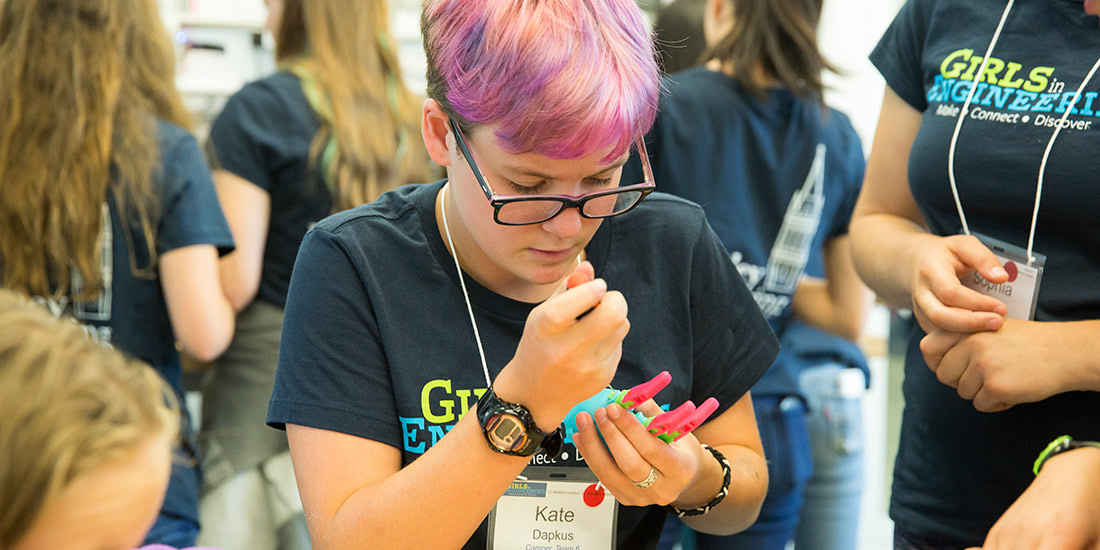 Campers assemble prosthetic hands (Matt Beardsley photo)
Campers assemble prosthetic hands (Matt Beardsley photo)Young makers build prosthetic hands for children in need
On Tuesday afternoons in June and July, 30 middle school-aged girls gather in one of the maker spaces in Jacobs Hall. They are participants in one of four weeklong sessions of Girls in Engineering, a summer program at Berkeley designed to increase diversity in STEM fields by inspiring girls about the wonders and impact of engineering and scientific inquiry.
Now in its third year, Girls in Engineering is part of the college’s comprehensive approach to increasing the representation of women in engineering. During the weeklong program, the group hears from women faculty and students engaged in a wide range of research, and goes on field trips to visit Bay Area companies applying engineering in non-academic settings.
Today, amidst the soft whirl of 3-D printers layering colorful filament, the girls pull up stools to wood-topped work benches. Jacobs Hall, home to the Jacobs Institute for Design Innovation, is the central hub of all things design at the college, and first the girls receive a primer on design thinking. In a moment, they’ll get to do some hands-on building.
At the front of the room, mechanical engineering doctoral student Aimee Goncalves offers a brief introduction about additive manufacturing and 3-D printing, and the opportunities inherent in speed and cost-effective prototyping. “3-D printing makes things more accessible because we can make stuff quicker and cheaper than before,” Goncalves says.
One of the latest applications is using 3-D printing and open-source file-sharing to build custom hand prosthetics for kids who need them. The girls watch a video about Sophie’s super hand, a project begun in the CITRIS Invention Lab last summer.
“The big thing with kids’ prosthetics,” Goncalves says, “is that they outgrow them quickly and need new ones. Another thing is that these prosthetics are customizable.”
Then Goncalves says that today the group will assemble prosthetic hands from parts fresh off the printers. “We will be making five hands,” she says, “which we will donate at the end of the day.” The hands will go to a project called the Prosthetic Kids Hand Challenge, which matches makers of prosthetics with kids who need them. The activity was created by Jacobs trainer Stacy Jo Scott based on open-source designs made available by Enabling the Future, a web community that sponsors the hand challenge. Scott designed the activity to give the girls the chance to experience how 3-D printing can make a difference in a child’s life.
By now, the tables are strewn with parts. The girls, some with digital calipers, others with small orange dead blow mallets, get to work assembling the tiny parts into a working hand.
In the end, this will become one of the students’ favorite activities. Building is fun, but building with a mission is what seems to inspire these girls.
Like for Josephine Teran, who will be entering Stanley Middle School in Lafayette this fall. “I liked that the parts were printed on a 3-D printer,” she says. “And I liked that we got to make a hand for someone.”
“Design provides a powerful toolkit with which our future engineers will change the world,” says Emily Rice, program director at the Jacobs Institute. To that end, Girls in Engineering program director Lizzie Hager-Barnard adds, “We hope to see some of these girls back here on campus in another five years or so.”
Girls in Engineering, an outreach program of the UC Berkeley College of Engineering, is supported by the National Science Foundation, the Peggy and Jack Baskin Foundation, SanDisk and Crunchyroll. Field trip hosts have included Pixar, Twitter, Plant PV and Sungevity.
Related links:
Camp gives middle school girls hands-on experience in engineering
More women in engineering – what’s working?
Berkeley’s Girls in Engineering Camp (video)
Girls in Engineering camp, Summer 2015 (video)
Girls in Engineering camp, June 2014 (video)
Berkeley Engineering launches Girls in Engineering summer camp